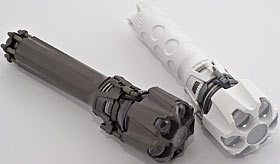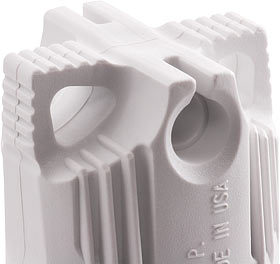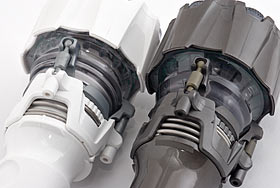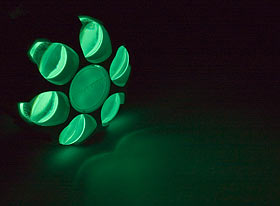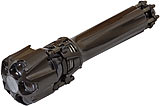
LumaRay FL6-2006 LED flashlight
Review date: 15 October 2006 Last modified 17-Aug-2012.
LumaRay, as I've pointed out in my previous reviews of their products, have managed the difficult feat of making a highly science-fictional-looking gadget that actually works perfectly well.
The LumaRay FL6 and FL12 LED flashlights are not incredible, world-changing products, but they look completely unlike anybody else's lights, have some genuinely interesting features besides their freaky appearance, aren't stupidly expensive for what they are, and do actually work. Which is more than you can say for most sci-fi-looking devices.
So I was pleased when LumaRay sent me their "FL6-2006", the latest revision of their original FL6 flashlight.
When I first checked out the FL12, the LumaRay model released after the FL6, I noted that the LEDs in the 12-diode FL12 are considerably better than the ones in the FL6. So the FL12's rather brighter, but also runs for longer from one set of three C batteries. The FL6 runs at "full brightness" for longer, but one of the major selling points of LED flashlights is that they continue to work for a very long time on tired batteries, at lower brightness. And the FL12's better at that than its six-LED sibling.
LumaRay's lights also have a phosphor coating around the LEDs that glows after you turn the flashlight off. The FL12 I reviewed had much brighter phosphor than the older FL6.
So, obviously, it wouldn't hurt to put FL12 LEDs and phosphor into an FL6. And LumaRay have done just that, in the FL6-2006.
If that was all they'd done then the new FL6 wouldn't be worth another review. But they've tweaked a few more things too.
Like the colour.
The older LumaRay lights came in any colour you wanted, as long as it was "Gunmetal". You can still get that greenish-grey colour, but there's now also black, yellow-and-grey, and this rather striking white version, with grey accents.
The FL6-2006 still looks like a sci-fi prop, but this version seems very Starfleet Medical to me. It's straight out of NCC-58925.
The design's also changed a bit, as you can see if you look at the '06 next to an original LumaRay.
The smooth and slightly slippery flutes on the older light's body have been replaced by grippier roundels, with a shallow depression behind the lamp assembly for you to hang onto.
And the Vader-mask tusks on the end of the body...
...have been replaced by a less avant-garde moulded tailpiece that still gives you plenty of ways to hook on a lanyard or something,
The new end also makes the FL6 about half an inch shorter.
They've fiddled slightly with the lamp and retaining mechanism design, as well. On the down side, this means that old LumaRay heads won't fit on the new handle. The new heads fit fine on old handles, though, and the new design is better.
It now features a pair of negative contact strips instead of just one, which means the light should survive considerably longer without going dim or intermittent - not that it seemed particularly prone to that before. The head also seals more tightly to the body so the light's now waterproof to 50 feet, versus 15 feet for the older LumaRays. And the twisty part of the head retaining mechanism has a clicky detent to hold it in place. The whole thing feels a bit more solid, if you ask me.
(The tighter waterproofing makes it harder to turn the head to turn the light on and off, but you can remove one O-ring to make the 2006 FL6 back into the original version in this department.)
The really important part, of course, is the lamp.
Thanks to the same Nichia CS LEDs that LumaRay use in the FL12, it's supposed to be about twice as bright as the old FL6.
And yes, it is. From three moderately fresh alkaline C cells totalling 4.7 volts, the FL6-2006's output peaked at a very creditable 825 lux, versus the 430 lux I got from the old FL6 when it was running from absolutely tippy-top new batteries.
The FL12's a bit brighter again, as you'd bloomin' well want it to be since it's got twice as many LEDs But six of its LEDs throw a wider beam than the other six, so it's hard to compare.
As with the older FL6, the lenses over the LEDs in the 2006 model give it an unusually tightly defined beam, with a quite evenly lit spot maybe 15 degrees wide in the middle, a fuzzy fringe out to 20 degrees at most, and not a whole lot of spill beyond that.
This beam isn't really super-narrow; you can use it perfectly well to see where you're going at night as well as for spotting things at a distance, and the FL6's brightness is also more than enough for you to use it as a lantern by standing it on its tail and pointing it at the ceiling.
If all you really want to do with your flashlight is see what you're about to step on, though, a 15 degree beam is not what you want. Get a more conventional broad-beam LED light instead.
If a 15 degree beam is OK with you, though, the new FL6's higher brightness gives it quite impressive performance for a mere six-LED light.
The minimum illumination level at which most humans can see colour is one lux. Assume your batteries are not perfectly fresh from the packet and so your FL6 is only delivering 800 lux at one metre, and it'll manage one-lux illumination at a distance of 28 metres. At that distance, its 15 degree spot will cover an area well over seven metres wide.
The minimum illumination level at which most people can see at all, when their eyes are adjusted to the dark, is about 0.1 lux. An FL6 will manage that level of illumination at almost ninety metres (which is getting on for football-field distance), and will light a circle some 24 metres across at that range.
Now, this isn't searchlight performance, and it's certainly not up there with the more entertaining excesses of the LED flashlight designer's art. But the FL6 is a quite lightweight and compact three-C-cell light. Funny-looking though it is, it's the same size as zillions of normal cheap supermarket flashlights. You can fit it in a middle-sized purse, and even stuff it into a front pants pocket if you have to (not at all comfortably, but it's possible). By the standards of other lights this size, the FL6 is quite startlingly bright, and it's also got the lovely even blue-white beam you can expect from any LED flashlight, which not only looks far more pleasant than the uneven yellowish light from an incandescent bulb and reflector, but actually lets you see better per watt of light, because the human eye is more sensitive to this "whiter" light.
LumaRay, by the way, proudly claim the FL6's brightness to be about "700,000 millicandelas", while pointing out that "similar 6 LED flashlights only produce ~43,000 mcd".
But, as I observed in my very first LED light review, the candela measures luminous intensity in a given direction. So it's not surprising that a flashlight like the FL6, with a quite tightly focussed beam, scores much better than ordinary wide-beamed LED flashlights.
The FL6 does deserve to be called twice as bright as your average six-5mm-LED flashlight (LumaRay also quote it as delivering about 70 lumens, which is a less fudgeable statistic). But it's not extraordinarily bright in absolute terms. There are tons of flashlights out there now that use one-watt or higher Luxeon-type LEDs; even the smallest of those are those are good for ten times the output of even the brightest standard 5mm white LEDs.
The FL6 is very respectably bright for its size, weight and battery consumption, though.
LumaRay quote the FL6-2006's total battery life at 600 hours, with a "high brightness" period of 20 hours. That's quite a lot better than the old FL6 managed.
Battery life numbers for electrically simple LED lights like the FL6 are somewhat fuzzy, because these things'll keep glowing practically forever on one set of batteries if they have to. You'll be down to old-mobile-phone-keypad light levels if the batteries are really clapped out, but that can still be enough to save your life in an emergency.
The FL6-2006 lamp starts to glimmer way down around 2.3 volts - that's 0.77 volts per cell, from cells that're meant to deliver 1.5V each. It delivers what I'd call decent light at only 2.7 volts; that's 0.9 volts per cell, which is the lowest "cutoff" voltage you're likely to see on 1.5 volt battery datasheets. Nought point eight volts per cell is the cutoff figure that battery companies use when they want to make their batteries look as if they last longer than they usually actually do, but there'll be a bit more run time below even that with the FL6-2006.
At 3.6 volts, which the FL6 will get if you use NiMH or NiCd rechargeable C cells in it, the lamp runs at quite respectable - though far from maximum - brightness and draws about 170 milliamps. Since 4500 milliamp-hour NiMH C cells are easy to find these days, that means a theoretical run time of more than 26 hours, followed by a pretty quick death - rechargeables lose voltage very rapidly when they're running out of charge.
In practice, NiMH and NiCd cells slowly "self discharge" when they're not being used, so you'll never see the full run time you expect. Still, though, an FL6 should work pretty nicely with any decent rechargeables.
At 4.5 volts, the FL6-2006 lamp draws a bit more than half an amp. That means it's unlikely to ever actually see 4.5 volts from three C alkalines; half an amp is a heavy enough load for them that they'll sag a bit below 1.5 volts per cell. Because this is a simple light without a regulator to boost the output of sagging batteries (regulators give you more "high brightness" operation, at the price of total battery life), the drain on the batteries will soon drop a bit more. So the 20/600 hour figure's plausible enough.
You'll even get decent battery life if you use the FL6-2006 from carbon-zinc "super heavy duty" batteries; they're considerably cheaper per minute of light.
If you can afford the flashlight, of course, you can probably also afford alkalines. The FL6-2006 has a "Regular Price" of $US74.95, but as I write this there's a "Limited Promotional Price" of $US69.95, the same as the price of the previous FL6. The LumaRay online store is only for people outside the USA; US shoppers can buy FL6s from ThinkGeek.
FL12s are on sale at the moment, too, but as a "special order" item, and they're only five bucks cheaper than they were, anyway $US114.95. They still only come in the Gunmetal colour, but they now have the 2006-style handle. The "special order" thing is presumably because there's an "FL12-RX" model with as-yet-unspecified new features, coming Real Soon Now.
These prices don't include shipping, and LumaRay's international shipping fees are a bit on the steep side. But, uh, the lights do come in a very nifty Toblerone-shaped box.
Oh, and yes, it glows. The new FL6 does indeed have the same bright glow-phosphor as the FL12 I reviewed - actually, it's noticeably brighter than even the FL12, at least if you've left both flashlights on for a while.
If your eyes are adjusted to the dark, the phosphor's usable as a dim close-range flashlight all by itself (thanks in no small part to the fact that it's green - human eyes are most sensitive to green light), for at least a few minutes. If your flashlight was on for a minute or so less than a minute ago, you'll be able to use it to find a keyhole or read your watch without turning it on again.
The main purpose of the glow-phosphor is just so that you can find your flashlight, of course, and it works fine for that for quite a while after being turned off. Some light from the main beam and the phosphor leaks out around the back of the lamp, so you can spot the light from all angles.
Overall
The new FL6 genuinely does have twice the brightness of the old model (and it should be brighter at any given battery level, too), with better battery life, and the same freaky-yet-practical design and operation.
It's still not a must-have product, and the fact that it looks like a prop from someone's no-budget sci-fi show will completely turn off some people.
But this thing actually looks rather better than many of the props from a lot of commercial sci-fi, and has the further advantage that it actually works.
The 2006 upgrade has bumped the FL6 from merely good to "recommended", for me.
Review flashlight kindly provided by LumaRay.
Big brother
I review the LumaRay FL12 here.
Ancestor
I review the LumaRay FL6 here.

